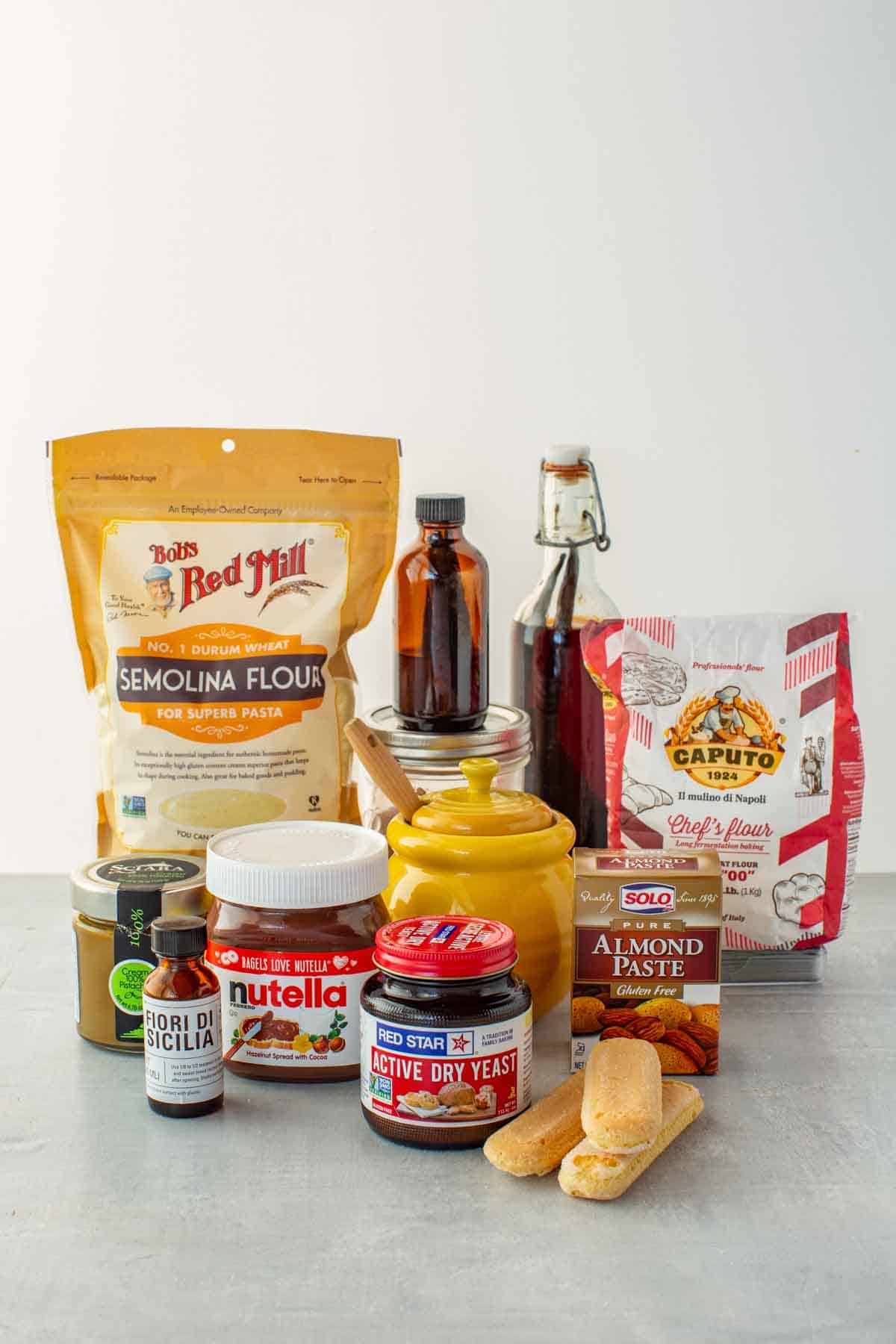Italian Baking Essentials
Italian cuisine is not only pasta and pizza but also delicious baked goods. From crispy pastries and soft focaccia to cakes, pies, cookies, and so much more. With these staple Italian baking essentials, you'll be able to make any Italian baked goods you desire.

Italian baking has a wide array of flavors that can transport you to the hills of Tuscany, the bustling streets of Naples, or the coast of Sicily.
Many people around the world love these treats, especially after trying them on holiday in Italy or from their local Italian deli, and want to recreate them at home. But to bake like a true Italian, you need some key baking essential ingredients, that may be different from what you're used to. This guide will walk you through everything you need to know to start baking Italian-style.
History and Culture
Italian baking is deeply rooted in the country's history and culture. Italy's diverse regions each have their own unique flavors and techniques. In ancient Rome, baking was already a sophisticated art, with bread being a staple of the Roman diet. Over centuries, as Italy developed and its regions maintained distinct identities, a variety of breads and pastries evolved.
In the north, you find rich, buttery pastries influenced by neighboring France and Austria, like the famous Panettone from Milan or the puff pastries of Trentino-Alto Adige. Moving south, the recipes become simpler but just as flavorful, with olive oil replacing butter in many recipes. In Sicily, you encounter sweets influenced by Arab cuisine, such as cannoli and marzipan. Many recipes are handed down through generations, carrying stories and memories.
Dry Italian Baking Essentials
- 00 Flour: A finely ground, soft wheat flour ideal for delicate doughs. Use it for making pasta, pizza dough, gnocchi, and light, airy cakes for an authentic Italian texture.
- Semolina: A coarser flour made from durum wheat, known for its yellow hue. Perfect for making rustic breads with a firm texture, but also semolina cake.
- Chestnut Flour: A gluten-free flour made from dried chestnuts, offering a sweet, nutty flavor. Great for traditional Tuscan desserts like castagnaccio and adding a unique taste to baked goods and cookies.
- Ammonia: Ammonium bicarbonate, used as a leavening agent in Italian baking. Ideal for crisp, light-textured cookies like biscotti and canestrelli. Use in well-ventilated areas due to its strong odor during baking.
- Cremor Tartaro (Cream of Tartar): A byproduct of winemaking, used to stabilize egg whites and act as a leavening agent. Essential for meringues, angel food cake, and light, fluffy baked goods.
- Nuts: Commonly used nuts in Italian baking include almonds, pine nuts, and hazelnuts. Use almonds for biscotti and cakes, pine nuts for traditional cakes like torta della nonna, and hazelnuts for adding crunch to various desserts.
- Marzapane (Marzipan/Almond Paste): A sweet, dense paste made from ground almonds and sugar. Perfect for making Italian cookies like amaretti and adding richness to pastries and cakes. It's also shaped as fruits and eaten on his own in Sicily.
- Yeast: Essential for leavening bread and doughs, available as active dry or fresh yeast. Use fresh yeast for traditional Italian breads like ciabatta and focaccia for a robust flavor and quicker rise.
- Vanillina: A powdered vanilla flavoring used in Italian baking. Ideal for flavoring cakes, cookies, and pastries where liquid vanilla extract might alter the consistency.
- Savoiardi: Also known as ladyfingers, these are light, airy sponge biscuits. Essential for making tiramisu and other layered desserts like zuppa inglese. Try them in my Tiramisu Brownies or this Pumpkin Tiramisu!
- Candied Fruit: Fruits that have been preserved in sugar, adding sweetness and texture. Use in festive breads like Panettone and desserts like cassata for a burst of color and flavor. Common candied fruits are orange, cherries, and citron.
Wet Italian Baking Essentials
- Extracts: Concentrated flavors derived from natural ingredients, commonly used in small amounts. Common extracts are vanilla, almond, citrus extracts to enhance the flavor of cakes, cookies, and pastries. Orange flower extract is also essential for some traditional desserts like Pastiera.
- Honey: Honey is common is widely produced in Italy. Ideal for adding depth and sweetness to breads, cakes, and cookies, as well as drizzling over finished desserts.
- Grano Cotto: Pre-cooked wheat grains used in traditional Italian recipes. Essential for making pastiera Napoletana, a classic Easter pie, and other grain-based desserts.
- Ricotta: A creamy, soft cheese with a mild, slightly sweet flavor. Use in fillings for cannoli, cheesecakes, and savory pastries for a rich, creamy texture.
- Alchermes Liqueur: A bright red Italian liqueur flavored with cinnamon, cloves, and vanilla. Traditionally used to color and flavor desserts like zuppa inglese and other pastries for a unique, aromatic touch.
- Sweet Nut Butters: From the iconic Nutella, to sweet delicious Pistachio cream, but also almond cream and hazelnut cream. They're perfect fillings for pies, cookies, cakes, and desserts.
Quality and Authenticity
Ensuring the quality and authenticity of your ingredients is crucial for achieving genuine Italian flavors. Here are some tips to help you identify and use authentic Italian products:
- Check the Origin: Authentic Italian ingredients often have their place of origin prominently displayed. For example, true extra virgin olive oil will state its origin, such as "Product of Italy."
- Buy from Reputable Sources: Specialty Italian stores, online retailers with good reviews, and authentic Italian brands are your best bet for quality ingredients.
- Seasonal Ingredients: Some ingredients are best used during specific seasons. For instance, good quality chestnut flour is easier to find after the harvest in October/November and it has a short expiration date because of the lack of preservatives.
Famous Italian Brands: Caputo, Paneangeli, D'Amico, Cameo, Elah.
Italian Desserts
With these staple Italian baking essentials in your pantry, you'll be able to make many authentic and traditional Italian desserts of all kinds.
Buying and Storing Tips
Buy your Italian baking essentials in Italian specialty stores, local deli, or online from stores with good reviews. Research the best brands for each ingredient to make sure they're authentic Italian imported ingredients.
Store the ingredients (except for Ricotta), in a dry and dark environment, like your pantry. Keep away from heat and light as much as possible to avoid spoilage.
FAQ
00 flour is much finer and creates a smoother dough, making it ideal for delicate pastries and pasta. All-purpose flour is coarser and has a higher gluten content, making it suitable for a broader range of baking needs but not as specialized.
Yes, ammonia (ammonium bicarbonate) is safe to use in baking and is commonly used for creating light, crispy cookies. Ensure adequate ventilation as it can emit a strong smell during baking.
Drain the ricotta in a fine mesh strainer or cheesecloth before using it in your recipes to remove excess moisture.
Fresh yeast has a shorter shelf life but provides a robust flavor and quick rise, while active dry yeast is more convenient with a longer shelf life but requires activation in warm water.
This post may contain affiliate links.




